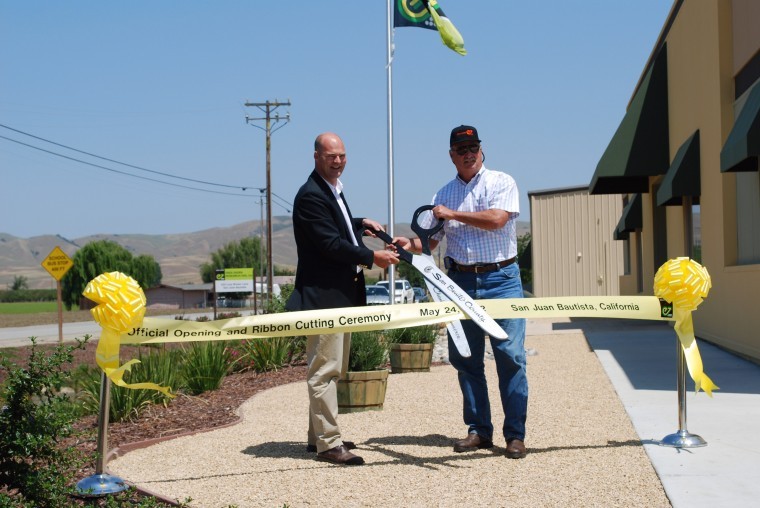
Enza Zaden, a seed research and development company headquartered in the Netherlands, celebrated the expansion of its operations at its lab facilities in San Juan Bautista on Thursday.
The ribbon cutting ceremony for a new office and laboratory on Lucy Brown Lane also marked the first building in San Benito County built to Leadership in Energy and Environmental Design standards. The company still had a few final steps to complete before receiving its certification on the day of the ceremony.
Don Marcus, of Marcus Building Systems, said the construction of the building was done with local subcontractors and that he was impressed with Enza Zaden’s commitment to getting the LEED certification.
“It cost 25 to 30 percent more (on construction) to make it work,” Marcus said. “To be part of the first LEED-certified project makes us very proud.”
Enza Zaden’s San Juan operations consist of a laboratory and greenhouse buildings where researchers test seeds to find out what stock offers the best resistance to pests as well as what seeds produce plants that have the qualities that growers and processors want in a final product.
Ronald Welten, the breeding station manager, said the idea to make the building environmentally-friendly came from Hollister architect David Huboi, who drew up the blue plans for the project.
“When we first met he started talking about going green,” Welten said. “I was still kind of skeptical. I asked if we were going to grow veggies on the roof. But as the process went on I got more excited.”
Welten said Enza Zaden now has plans to use the LEED certification process for a new building at its location in Florida, thanks to Huboi.
The company also worked with Kelley Engineering and Surveying before Marcus began construction. Welten said he got a lot of support from San Benito County and the Economic Development Corp. of San Benito County through the permitting process.
Joep Lambalk, the managing director of research and development, flew in for the event. He said though Enza Zaden has offices or research centers in 20 countries worldwide with plans to expand to India, South Africa and Brazil, he does not think of the company as “multi-national.” The company started out with 80 employees in the Netherlands.
“It is a small, independently owned family business,” he said, noting that the company likes to stay involved in the local community in each location.
Debbie Taylor, the president and CEO of the San Benito County Chamber of Commerce, said Enza Zaden has long been a member of the chamber.
“We are proud they chose this site (to expand,)” she said. “It puts us on the map.”
As part of the day’s festivities, Enza Zaden workers offered a tour of their new building facility in which they introduced visitors to the work they do. The employees in Hollister work on developing seeds for peppers, tomatoes and onions that are resistant to pests. But Anne Marie Welten said more recently they have started working on “post-harvest research.”
“Nowadays, we are not only growing the plants, but looking a little bit further to give added value,” she said.
Some of the research includes looking at the shelf live of produce and the nutritional value.
“It’s very difficult to tell if you pick, wash and bag lettuce how long it will last,” she said.
She said the employees have a space were they can pick their experimental varieties, wash them and see how long they last.
Another factor, of course, is taste. For peppers, they use a meter to see how hot the peppers are.
The seeds of all the varieties developed in San Juan and other breeding stations are stored in the Netherlands.
Nicki Phillips, who showed the facility to guests, said they do not usually allow random people to walk through the lab. The main concern is keeping pathogens out so samples can be imported and exported to other countries.
Outside the building, Welten pointed out the nurseries around the property. He said the employees grow produce year round, but none for consumption.
He said they often allow the plants to stay in the ground after they ripen to test the harvest windows. Welten pointed to some posts that will be used for a new greenhouse.
“We are hardly finished with this building and we are starting to build again,” he said.









